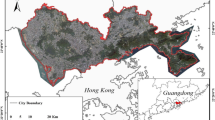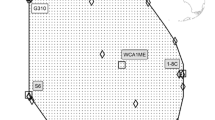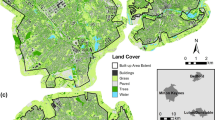Abstract
Numerical clustering has frequently been used to define hierarchically organized ecological regionalizations, but there has been little robust evaluation of their performance (i.e., the degree to which regions discriminate areas with similar ecological character). In this study we investigated the effect of the weighting and treatment of input variables on the performance of regionalizations defined by agglomerative clustering across a range of hierarchical levels. For this purpose, we developed three ecological regionalizations of Switzerland of increasing complexity using agglomerative clustering. Environmental data for our analysis were drawn from a 400 m grid and consisted of estimates of 11 environmental variables for each grid cell describing climate, topography and lithology. Regionalization 1 was defined from the environmental variables which were given equal weights. We used the same variables in Regionalization 2 but weighted and transformed them on the basis of a dissimilarity model that was fitted to land cover composition data derived for a random sample of cells from interpretation of aerial photographs. Regionalization 3 was a further two-stage development of Regionalization 2 where specific classifications, also weighted and transformed using dissimilarity models, were applied to 25 small scale “sub-domains” defined by Regionalization 2. Performance was assessed in terms of the discrimination of land cover composition for an independent set of sites using classification strength (CS), which measured the similarity of land cover composition within classes and the dissimilarity between classes. Regionalization 2 performed significantly better than Regionalization 1, but the largest gains in performance, compared to Regionalization 1, occurred at coarse hierarchical levels (i.e., CS did not increase significantly beyond the 25-region level). Regionalization 3 performed better than Regionalization 2 beyond the 25-region level and CS values continued to increase to the 95-region level. The results show that the performance of regionalizations defined by agglomerative clustering are sensitive to variable weighting and transformation. We conclude that large gains in performance can be achieved by training classifications using dissimilarity models. However, these gains are restricted to a narrow range of hierarchical levels because agglomerative clustering is unable to represent the variation in importance of variables at different spatial scales. We suggest that further advances in the numerical definition of hierarchically organized ecological regionalizations will be possible with techniques developed in the field of statistical modeling of the distribution of community composition.





Similar content being viewed by others
References
Andréfouët S, Claereboudt M (2000) Objective class definitions using correlation of similarities between remotely sensed and environmental data. International Journal of Remote Sensing 21:1925
Bailey RG (1996) Ecosystem geography. Springer-Verlag, New York, NY, p 216
Bailey RG (2004) Identifying ecoregion boundaries. Environmental Management 34:S14–S26
Belbin L (1993) Environmental representativeness: regional partitioning and reserve selection. Biological Conservation 66:223–230
Bunce RGH, Barr CJ, Gillespie MK, Howard DC (1996) The ITE land classification: providing an environmental stratification of Great Britain. Environmental Monitoring and Assessment 39:39–46
Burrough PA, McDonell RA (1998) Principles of geographical information systems. Oxford University Press, New York, p 190
Cumming G, Fidler F, Vaux DL (2007) Error bars in experimental biology. Journal of Cell Biology 177:7–11
De’ath G (1999) Extended dissimilarity: a method of robust estimation of ecological distances from high beta diversity data. Plant Ecology 144:191–199
De’ath G, Fabricius KE (2002) Classification and regression trees: a powerful yet simple technique for ecological data analysis. Ecology 81:3178–3192
Ferrier S, Guisan A (2006) Spatial modeling of biodiversity at the community level. Journal of Applied Ecology 43:393–404
Ferrier S, Manion G, Elith J, Richardson K (2007) Using generalized dissimilarity modeling to analyze and predict patterns of beta diversity in regional biodiversity assessment. Diversity and Distributions 13:252–264
Guisan A, Zimmermann NE (2000) Predictive habitat distribution models in ecology. Ecological Modeling 135:147–186
Hargrove WW, Hoffman FM (2004) The potential of multivariate quantitative methods for delineation and visualization of ecoregions. Environmental Management 34:S39–S60
Hastie T, Tibshirani R, Friedman JH (2001) The elements of statistical learning: data mining, inference, and prediction. Springer-Verlag, New York
Johnson RA, Wichern DW (1998) Applied multivariate statistical analysis, 5th edn. Prentice Hall, New Jersey, p 800
Kaufman L, Rousseeuw PJ (1990) Finding groups in data. An introduction to cluster analysis. Wiley and sons, Inc, New-York, p 342
Klijn F, Udo de Haes HA (1994) A hierarchical approach to ecosystems and its implications for ecological land classification. Landscape Ecology 9:89–104
Leathwick JR, Overton JM, McLeod M (2003) An environmental domain analysis of New Zealand, and its application to biodiversity conservation. Conservation Biology 17:1612–1623
Legendre P, Lapointe F-J, Casgrain P (1994) Modeling brain evolution from behavior: a permutational regression approach. Evolution 48:1487–1499
Legendre P, Legendre L (1998) Numerical ecology, 2nd edn. Elsevier, Amsterdam, The Netherlands, p 853
Levin SA (1992) The problem of pattern and scale in ecology. Ecology 73:1993–1993
Lichstein JW (2007) Multiple regression on distance matrices: a multivariate spatial analysis tool. Plant Ecology 188:117–131
Loveland TR, Merchant JM (2004) Ecoregions and ecoregionalization: geographical and ecological perspectives. Environmental Management 34:1–13
Mackey BG, Berry SL, Brown T (2008) Reconciling approaches to biogeographical regionalization: a systematic and generic framework examined with a case study of the Australian continent. Journal of Biogeography 35:213–229
Mackey BG, Nix HA, Hutchinson MF, McMahon JP, Fleming PM (1988) Assessing representativeness of places for conservation reservation and heritage listing. Environmental Management 12:501–514
McMahon G, Gregonis SM, Waltman SW, Omernik JM, Thorson TD, Freeouf JA, Rorick AH, Keys JE (2001) Developing a spatial framework of common ecological regions for the conterminous united states. Environmental Management 28:293–316
Metzger MJ, Bunce RGH, Jongman RHG, Mücher CA, Watkins JW (2005) A climatic stratification of the environment of Europe. Global Ecology and Biogeography 14:549–563
Mielke PWJ (1979) On the asymptotic nonnormality of null distributions of mrpp statistics. Communications in Statistical Theory and Methods 8:1541–1550
Omernik JM (1987) Ecoregions of the conterminous united states. Annals of the Association of American Geographers 77:118–125
Omernik JM (2004) Perspectives on the nature and definition of ecological regions. Environmental Management 34:S1–S13
Omi PN, Wensil LC, Murphy JL (1979) An application of multivariate statistics to land-use planning: classifying land units into homogeneous zones. Forest Science 25:399–414
O’Neill RV, DeAngelis DL, Waide JB, Allen TFH (1986) A hierarchical concept of ecosystems. Princeton University Press, Princeton, New Jersey, p 249
R Development Core Team (2004) R: A language and environment for statistical computing. R Foundation for Statistical Computing, Vienna, Austria
Sheail J, Bunce RGH (2003) The development and scientific principles of an environmental classification for strategic ecological survey in the United Kingdom. Environmental Conservation 30:147–159
Snelder T, Leathwick JR, Dey K (2007) A procedure for making optimal selection of input variables for multivariate environmental classifications. Conservation Biology 21:365–375
Snelder TH, Leathwick JR, Dey KL, Rowden AA, Weatherhead MA, Fenwick GD, Francis MP, Gorman RM, Grieve JM, Hadfield MG, Hewitt JE, Richardson KM, Uddstrom MJ, Zeldis JR (2006) Development of an ecologic marine classification in the New Zealand region. Environmental Management 39:12–29
Snelder TH, Pella H, Wasson J, Lamouroux N (2008) Definition procedures have little effect on performance of environmental classifications of streams and rivers. Environmental Management 42:771–788
Trakhtenbrot A, Kadmon R (2005) Environmental cluster analysis as a tool for selecting complementary networks of conservation sites. Ecological Applications 15:335–345
Tran LT, Knight CG, O’Neill RV, Smith ER (2002) Self-organizing maps for integrated environmental assessment of the mid-Atlantic region. Environmental Management 31:882–882
Van Sickle J (1997) Using mean similarity dendrograms to evaluate classifications. Journal of Agricultural, Biological and Environmental Statistics 2:370–388
Webb JA, Bond NR, Wealands SR, MacNally R, Quinn GP, Vesk PA, Grace MR (2007) Bayesian clustering with AUTOCLASS explicitly recognizes uncertainties in landscape classification. Ecography 30:526–536
Wiken EB, Ironside G (1977) The development of ecological (biophysical) land classification in Canada. Landscape Planning 4:273–282
Zar JH (1999) Biostatistical analysis, 3rd edn. Prentice-Hall, New Jersey, p 718
Zhou Y, Narumalani S, Waltman WJ, Waltman SW, Palecki MA (2003) A GIS-based spatial pattern analysis model for ecoregion mapping and characterization. International Journal of Geographic Information Science, 17
Zimmermann NE, Kienast F (1999) Predictive mapping of alpine grasslands in Switzerland: species versus community approach. Journal of Vegetation Science 10:469–482
Acknowledgments
Ton Snelder was supported by Marie Curie Incoming International Fellowship within the 6th European Community Framework Programme. We thank Niklaus Zimmermann of WSL (Swiss Federal Institute for Forest, Snow and Landscape Research) for climatic data and Mario Sartori and Daniel Ariztegui from the University of Geneva, as well as Andreas Baumeler from the Schweizerische Geotechnische Kommission for their help in preparing the geological data. Credit goes also to Ramona Maggini (University of Lausanne) for her initial work on this project and Martial Ferréol (CEMAGREF) for assistance with programming in the R language. Finally, we acknowledge the scientific and financial support of the Swiss Federal Office for the Environment. The original manuscript was improved by reviews made by Angus Webb and an anonymous reviewer.
Author information
Authors and Affiliations
Corresponding author
Rights and permissions
About this article
Cite this article
Snelder, T., Lehmann, A., Lamouroux, N. et al. Strong Influence of Variable Treatment on the Performance of Numerically Defined Ecological Regions. Environmental Management 44, 658–670 (2009). https://doi.org/10.1007/s00267-009-9352-2
Received:
Revised:
Accepted:
Published:
Issue Date:
DOI: https://doi.org/10.1007/s00267-009-9352-2




